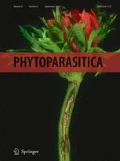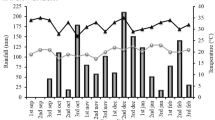Abstract
Post-emergence herbicides are useful for managing weeds in soybean fields. Use of post-emergence herbicide(s) is increasing in India because of the ease of use and control of broad spectrum of weeds. As soybean is a rainy season crop in India, weed control remains an important concern for soybean farmers. An experiment was laid out at Research Farm of Punjab Agricultural University, Ludhiana to study effect of different herbicides for control of grass weeds in soybean. Treatments comprised of post-emergence application of quizalofop 25, 37.5 and 50 g/ha, fenoxaprop 100 g/ha, weed free and unweeded control. Phyto-toxic evaluation of herbicides was carried out on succeeding wheat crop. Quizalofop 37.5–50 g/ha significantly reduced weed density and biomass of grass weeds compared to weedy check. Quizalofop 50 g/ha gave complete control (100%) of Dactyloctenium aegyptium, Digitaria sanguinalis, Acrachne racemosa and Eragrostis spp. till 40 days and > 85% till 80 days after treatment. Quizalopfop 50 g/ha recorded soybean seed yield and yield attributes similar to that of weed free check; it gave highest B:C (2.61) and net returns ($660/ha) All weed control treatments provided higher soybean seed yield compared to unweeded control. Quizalofop at all doses was safe to succeeding wheat crop.




Similar content being viewed by others
References
Balyan, J. K., Choudhary, R. S., Kumpawat, B. S., & Choudhary, R. (2016). Weed management in blackgram under rainfed conditions. Indian Journal of Weed Science, 48, 173–177.
Benke, P. S., Deshpande, R. M., Yenprediwar, M. D., & Pagar, P. C. (2012). Effect of time of application and concentration of quizalofop on weed control in soybean. Journal Soils and Crops, 22, 168–171.
Bhatt, R., Kukal, S. S., Busari, M. A., Arora, S., & Yadav, M. (2016). Sustainability issues on rice-wheat cropping system. International Soil & Water Conservation Research, 4, 68–83.
Dapke, S., Lambat, A., Gadewar, R., Charjan, S., & Dongre, V. (2014). Effect of different herbicides on weed control and yield in soybean (Glycine max L.). International Journal of Life Science, A2, 51–55.
Gill, G. S., & Vijaykumar. (1969). Weed index- a new method for reporting weed control trials. Indian Journal of Agronomy, 16, 96–98.
Kachroo, D., Dixit, A. K., & Bali, A. S. (2003). Weed management in oilseed crops- a review. Shaire-E-Kashmir University of Agricultural Science and Technology Journal of Research, 2, 1–12.
Kewat, M. L., & Pandey, J. (2001). Effect of pre-emergence herbicides on weed control in soybean (Glycine max). Indian Journal of Agronomy, 46, 327–331.
Kurchania, S. P., Rathi, G. S., Bhalla, C. S., & Mathew, R. (2001). Bioefficacy of post-emergence herbicides for weed control in soybean [Glycine max (L.) Merrill.]. Indian Journal of Weed Science, 33, 34–35.
Mani, V. S., Malla, M. L., Gautam, K. C., & Bhagwan, D. (1973). Weed killing chemicals in potato cultivation. Indian Farm, 27, 17–18.
Nandini, D. K., Singh, L. K., Mangang, A. C. N. J. S., Singh, B. N., Athokpam, S., Herojit, S., & Dorendro, A. (2016). Effect of weed control practices on weed dynamics, yield and economics of soybean [Glycine max (L.) Merrill]. Legume Research, 39, 995–998.
Prachand, S., Kalhapure, A., & Kubde, K. J. (2015). Weed management in soybean with pre- and post-emergence herbicides. Indian Journal of Weed Science, 47, 163–165.
SAS. (2011). SAS user’s guide, SAS institute, Cary, NC, USA.
Sharma, N. K., Mundra, S. L., & Kalita, S. (2016). Effect of weed control on growth and productivity of soybean. Indian Journal of Weed Science, 48, 90–92.
Shobha, R. (2001). Weed management and weed threshold models in soybean (Glycine max L.). M. Sc. (Agronomy) Thesis, Department of Agronomy, University of Agricultural Sciences, Bangalore.
Thakare, S. S., Deshmukh, J. P., Shingrup, P. V., Pawar, P. M., & Gahlop, A. N. (2015). Efficacy of different new herbicides against weed flora in soybean (Glycine max L.). Plant Archives, 15, 217–220.
Tuti, M. D., & Das, T. K. (2011). Sequential application of metribuzin on weed control, growth and yield of soybean (Glycine max). Indian Journal of Agronomy, 56, 57–61.
Yadav, R., Singh, M. S., Kaur, S., Kaur, T., & Jhala, A. (2017). Weed control in conventional soybean with pendimethalin followed by imazethapyr plus imazamox/quizalofop. Canadian Journal of Plant Science, 97, 1–11.
Acknowledgements
The authors are thankful to M/s Hyderabad Chemical Products Limited for funding to carry out this field experiment.
Author information
Authors and Affiliations
Corresponding author
Ethics declarations
Conflict of interest
The authors declare that they have no conflict of interest.
Additional information
Publisher’s Note
Springer Nature remains neutral with regard to jurisdictional claims in published maps and institutional affiliations.
Rights and permissions
About this article
Cite this article
Kaur, T., Kaur, S. & Bhullar, M.S. Management of grass weeds with quizalofop in soybean [Glycine max (L.) Merrill]. Phytoparasitica 47, 155–162 (2019). https://doi.org/10.1007/s12600-019-00717-2
Received:
Accepted:
Published:
Issue Date:
DOI: https://doi.org/10.1007/s12600-019-00717-2




